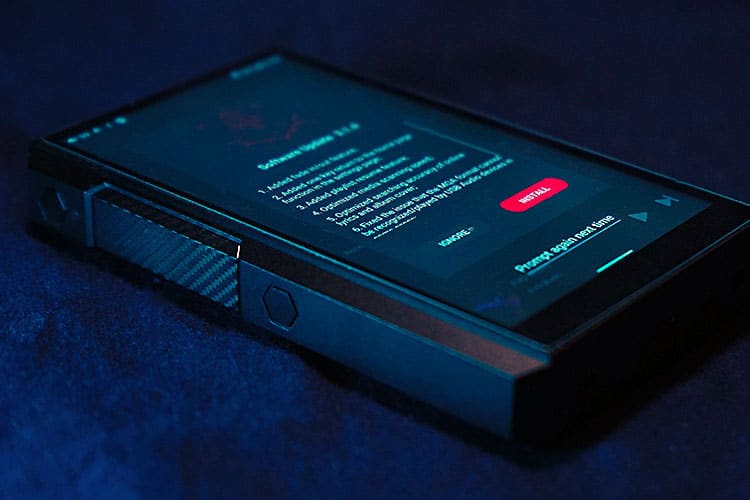
Today, we review the FiiO M11S which is an Android 10 DAP featuring a dual Sabre DAC, a snapdragon 660 CPU, and 670mW of output power. It is priced at $499.99.
Disclaimer: This was sent to us as a sample for our honest opinion. Headfonics is an independent website with no affiliate links or services. We thank FiiO for its support.
You can click here to learn more about the FiiO gear we have previously highlighted on Headfonics.
Note, that this post follows our latest scoring guidelines which you can read up on here.
The M11S is the newest iteration of the M11 series first launched in 2019 and inherits the previous higher-end M11 Plus ESS’s futuristic design language and comes in a sleeker profile.
Priced more aggressively at $499, M11S encases the powerful Snapdragon 660 controller and fuses dual ES9038Q2M SABRE DACs with amping circuitry design derived from the M11, achieving a whopping 670mW in the output.
The speed and specifications are extraordinary but how about the sound performance? It’s time to find out!

Tech Highlights
Speed
The M11S is very fast for a DAP this size featuring the 14nm 2.2GHz clocked Qualcomm Snapdragon 660 with 8 Kyro cores, the same controller unit as seen in FiiO’s flagship DAP M17.
Despite being announced in 2017 the Snapdragon 660 is still a capable and popular choice that balances nicely the performance and power consumption. It offers 3GB RAM and 64GB ROM which enables the M11S to operate extremely smoothly and respond speedily to swiping actions.
The M11S is BT5.0 and WiFi 5G capable so users can enjoy fast wireless connections with much fewer delays. Web surfing and file transfer over Wi-Fi are incredibly fast.
Decoding
FiiO has chosen the popular ESS ES9038Q2M decoding chipsets known for their high dynamic range and power efficiency.
The ES9038Q2M bears ESS’s patented 32-bit HyperStream II DAC architecture and Time Domain Jitter Eliminator, with the ability to deliver a dynamic range of up to 128dB with THD+N performance of –120dB. The adoption of SABRE DACs seems to bring the performance a step further and we will elaborate more in the sound section.
FiiO has stepped up the components around the decoding solution including the power section and time domain measures. This includes NDK femtosecond crystal oscillators installed for precise time signal to lower jitter in the digital stream, coupled with their 4th gen, custom-coded FPGA controller featuring phase-locked loop technology.
The M11S can decode up to DSD256 and 384kHz/32bit PCM and in USB DAC mode it supports DSD512 and 32bit/768kHz native decoding. For wireless, it supports LHDC codec on top of LDAC and other common codecs.
Amplification
FiiO uses the Texas Instruments OPA1612 for I/V stag, OPA1642 as LPF, and customized OPA926 for voltage amplification, similar to the configuration on the original M11 player. These OPAMPs are known for being stable, highly dynamic, and free from distortion.
To further enhance the technicalities, the power supply unit discreetly powers the different isolated sections to achieve better dynamics and brings down the noise floor to as low as 1.9μV, 60% less than its predecessor even when the output is more powerful.
Interestingly, the M11S scored <0.0004% THD+N which is superior to M11 PLUS LTD’s <0.00079%. Having the noise floor suppressed the M11S scores ≥ 123dB (A-weighted) in SNR which is quite decent on paper.

Design
FiiO has shrunk the size of the M11S from the M11 Plus ESS yet inheriting the button layout and accommodating a large 5”, 480×720 laminated IPS screen on its faceted CNC-ed body that is built like a tank. The size is perfect for the grip and the button layout is friendly for both right-handed and left-handed users.
Unlike some other FiiO players with a “sim-card tray” card slot, the M11S has an uncovered slot exposed on the right side for an instant card swap.
Flipping to the back that is normally hidden under the case, we have a plain glass panel that matches well the metallic framework, a reasonable move to cut down some cost on the visuals considering the positioning and price point.

Controls
Multi-function button
FiiO places a customizable button below the volume pad which behaves the same way as seen on the M11 Plus ESS.
Users can assign functions to the button when holding it, and these customizable functions include switching between Equalizers, entering Bluetooth Decoding Mode, adding the current song to the favorite list, deleting the current track, and more.
This is a very handy and practical feature that allows the user to spend less time navigating through menus for a function.

Volume control
The volume pad on the left side of the M11S, despite having the same design as seen on the M11 Plus, does not support swiping volume control.
To be honest I hope this could double as a slider but without that, the volume control still functions pretty well, there are 120 volume steps that allow precise volume adjustment with very sensitive IEMs.
In practice I prefer the big volume pad to the scroll wheels on the previous generation products as it slims down the design and you won’t accidentally click on it, it is also recommended to set the max volume just in case.
There are weaved carbon fiber patterns on the volume pad and clean feedback when clicking on it. Aside from the volume pad, the on-screen volume bar can also be used for fast volume increments.

I/O
Much like its brothers, the M11S has a stealthy black theme on its screwless chassis. Indexes are engraved next to the neatly aligned jacks at the bottom including 2.5mm, 4.4mm and 3.5mm outputs, nothing feels excessive and it looks pretty stylish.
The 4.4mm connection is the most powerful and can output as much as 670mW, if more power is needed you can hook up the M11S with an amplifier using its 4.4mm or 3.5mm lineout.
The M11S keeps the 3.5mm COAX function but you will need to buy a separate cable, the COAX output supports outputting 384kHz-32bit/DSD128 signal and can be used to connect to external decoders.
Battery
The M11S Supports QC4.0 quick charge and only requires 3 hours to fully charge its 5300mAh battery. With the new DAC and amping circuitry, the M11S achieves more than 14 hours of playback on high gain testing with 32Ω load and lossy files.
When playing lossless tracks on the same setting the playback time reduces by roughly 40%, which is more than sufficient for daily commutes.

Packaging & Accessories
As usual, the M11S comes in high-quality prints with color-shifting effects on the outline of the DAP. Only essential accessories are supplied and the player is preinstalled with a thick glass protector. A transparent case can be found in the packaging as well as a USB cable and user guides.


Software
Android 10
The M11S runs on a deeply customized Android 10 OS which bypasses SRC restriction globally. That allows the FiiO music app and other 3rd party applications to enjoy higher output quality, and users can switch to the in-built Pure Music Mode that minimizes noises by force closing background apps.
Users can switch between the Pure Music/USB DAC/Bluetooth Receiver/AirPlay modes from the drop-down menu and there is a cool dark theme mode that feels more contrasty under the sun.
You can also select the night mode in the drop-down menu which is very friendly to the eyes if you like to enjoy music in the dark by reducing blue light emission.
The overall UI experience is very responsive and similar to the experience on the older M11 and Pro versions that are proven stable and agile even after months of use, especially when FiiO supports OTA firmware updates to eliminate bugs or enhance certain functions.


Features
FiiO Music App
The preinstalled FiiO Music App is the main interface for media management, and audio playback as well as controlling other FiiO devices. You can remote control the player from your phone by using the FiiO Link function inside the app.
Another practical feature is the Wi-Fi music transfer function that allows sending of songs from the PC to the player over Wi-Fi.
The music playback screen is quite intuitive and supports swiping actions for the next/last song. Aside from these practical features, FiiO allows users to change the app theme, which makes the overall experience more fun and user-friendly.
MQA 8X
There are a handful of audio apps that support unfolding MQA files such as Tidal and UAPP, with 8X unfolding power automatically applied to MQA files, the output sounds slightly smoother and more refined.
Sometimes MQA has better mastering that sounds more engaging than its counterparts in other formats, which is definitely worth a try.
Pure Music Mode
Recommended as usual on FiiO players, the Pure Music mode can optimize the output quality. This mode drops other background apps and allows the FiiO Music App to work at full power without interference.
In a similar sense, it is recommended to turn off Wi-Fi when not in use to minimize the noise floor.
All To DSD
FiiO has been enhancing the All To DSD function which is a solid feature I would recommend. By switching it on the M11S can up-sample to DSD64 everything across the output.
The function applies globally to all apps and you can hear the output sounding more refined and delicate, also smoother in articulation. It works great with acoustic instruments and expressive voices but when it comes to lossy tracks or poorly defined music it may sound blurred or bloated.
When switching on All To DSD the player will also get hotter and drains the battery faster. FiiO claims that they have worked on the efficiency to allow the player to run longer on a single charge with this function on.
Apple Music
AIFF can be used on the M11S and you can stream over the phone to the M11S which acts as a BT receiver, at the same time Apple lossless at 32bit/384kHz is supported. You can stream to other speakers and Apple TV by Airplay which can be accessible in the drop-down menu.
Wireless Performance
Wi-Fi
The Wi-Fi performance is similar to what I have experienced on the M11 Plus ESS and LTD versions. With a 5GHz connection, streaming over WiFi is stable and fast. Within the living room and one room apart connection does not drop and I can stream 720P videos steadily.
Bluetooth
The M11S houses the SAMSUNG S5N5C10B01-6330 Bluetooth chipset and covers SBC/AAC/aptX/aptX HD/LDAC/LHDC Codecs.
The signal strength on the M11S is satisfactory and with Bluetooth 5.0 the connection is quite fast and stable. LDAC connection when testing with the FiiO K9 PRO ESS as the receiver is stable within a few meters and may start to drop if moving fast from the receiver.
USB-DAC
With USB 3.0 on board the M11S transfers files via USB really fast, but you will need to download a USB driver from FiiO’s website before using it as a decoder.
On the M11Plus LTD USB Audio has been limited to 384kHz-32bit PCM and DSD128 in USB-DAC mode, but this time it is expanded to 32bit/768kHz and DSD512 for both USB decoding and output mode.
Click on page 2 below for our sound impressions and select comparisons
creditSource link






